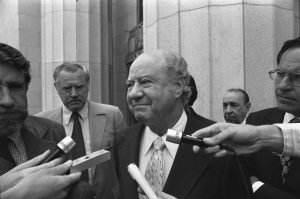Was Robert Maheu, an aide to Howard Hughes, responsible for Bobby Kennedy’s assassination?

Robert A. Maheu pauses outside federal court in Los Angeles in 1974, where a jury ruled that he had been defamed by billionaire Howard Hughes. A new book claims that Maheu, a longtime CIA operative, may have arranged the assassination of Sen. Robert F. Kennedy (D-N.Y.) (Bettmann/Bettmann Archive)
Robert A. Maheu was such a colorful character that it’s widely believed the television show “Mission: Impossible” was based on him and his private investigative agency.
As an ex-FBI agent, the CIA asked him to handle jobs it wanted to steer clear of, such as lining up prostitutes for a foreign president or hiring the mafia to kill Fidel Castro. For more than 15 years, Maheu and his Washington-based company were on monthly retainer to “The Agency,” CIA records show. And during much of that time, Maheu was the right-hand man to Howard Hughes as Hughes bought up vast swaths of Las Vegas and helped finance CIA operations.
Now, a new book alleges that Maheu may have performed another mission for the CIA: the assassination of Sen. Robert F. Kennedy (D-N.Y.).
A spokeswoman for the CIA declined to comment on the book’s allegations, though she acknowledged that Hughes did finance some CIA operations.
Maheu would have had access to the CIA’s experiments in hypnosis and mind control, which were being conducted at the time in California and elsewhere. That would have enabled him to frame Sirhan Sirhan as a patsy for the slaying of Kennedy, while other gunmen actually fired the fatal shots, argues author Lisa Pease, who spent 25 years researching her book, “A Lie Too Big to Fail.”
Pease is not the first person to link the CIA to the June 1968 assassination of Kennedy, in the pantry of the Ambassador Hotel in Los Angeles. Sirhan’s lawyers in 2010 accused the CIA of hypnotizing Sirhan and making him “an involuntary participant.” The agency may have feared Kennedy because he opposed the CIA’s expansive use of power and would have pressed the agency for answers in the assassination of his brother, President John F. Kennedy, five years earlier, Pease theorizes.
[Who killed Bobby Kennedy? His son, RFK Jr., doesn’t believe it was Sirhan Sirhan]
With Maheu’s contacts throughout the CIA and organized crime, he is “the most credible high-level suspect for the planner of Robert Kennedy’s assassination,” Pease wrote. Maheu died in Las Vegas in 2008 at age 90, after a career that the New York Times once described as having “aspects of a novel jointly written by Ian Fleming and Harold Robbins.”
Pease’s book builds on the work of numerous prior authors who concluded that Sirhan did not kill Kennedy but was convicted by the misdeeds of the Los Angeles police and district attorney, and the ineptitude of his defense lawyers, who never challenged any of the physical evidence. Chief among that evidence is the autopsy finding that Kennedy was shot point blank in the back of the head, while Sirhan was in front of Kennedy. Witnesses at the scene of the shooting were adamant that Sirhan never got close enough to fire at close range — he was pinned down by a hotel maître d’ after two shots from in front of Kennedy, and emptied the rest of his eight-shot pistol wildly while he was held down.
The courts in California have rejected such claims, and Sirhan has repeatedly been denied parole, most recently in 2016. He is serving a life sentence in a prison outside San Diego and has maintained since his arrest that he does not remember firing any shots at Kennedy. The Los Angeles District Attorney’s Office and police declined to comment for this story. A former Los Angeles assistant prosecutor has testified against Sirhan at parole hearings, but he, also, declined to be interviewed.

Kennedy speaking at the Ambassador Hotel in Los Angeles early on the morning of June 5, 1968, just past the midnight of June 4. He was shot shortly after the speech. Some critics allege that Sirhan Sirhan was wrongly convicted of the slaying. (Dick Strobel/AP)
Pease believes Sirhan had been hypnotized and was firing blanks, and she quotes witnesses who told police they saw shredded paper fluttering through the air as the shots were being fired, indicative of casings containing an explosive charge but no bullets. Pease cites witnesses, such as the wife of author George Plimpton, who said they saw gunmen behind Kennedy. One of those, an armed security guard named Thane Cesar, had previously worked for Maheu in Los Angeles, Pease found.
